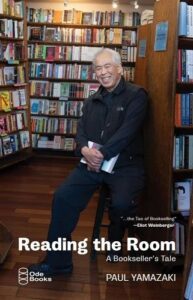Seminary Co-op booksellers and friends have held a number of conversations with legendary bookseller Paul Yamazaki throughout the past two years, in the intoxicating stacks of City Lights, perambulating the streets of San Francisco, and over whiskey tumblers deep into the night. With Paul we’ve edited them into the format of one day and night’s passage, collected to convey the essence of his wisdom, his passion for bookselling, and his life of letters, including the story of his tenure with the great City Lights, as well as to share the joy that it is to spend time in his presence.
*
Good morning! By the sober light of day, let’s wrap up with your thoughts about the future of the industry. Why do bookstores matter?
We are about the process of discovery. There has never been a year where there hasn’t been something that has threatened our existence as an industry or made life as booksellers challenging. Some of the most exciting and challenging bookstores are no longer with us.
I’m thinking of Midnight Special in Los Angeles, St. Mark’s Bookshop in New York, Hungry Mind in St. Paul, Minnesota, and Cody’s Books in Berkeley. Not to be able to go to those stores any longer, at least in my topography, makes the world much smaller.
Three Lives in the West Village of New York City and Green Arcade in the Hub neighborhood of San Francisco were the two jewel-box bookstores that bracket the continent. They were both wonderfully expansive and deep—Three Lives still is!—despite what many of us would think of as confining spaces of 600 to 800 square feet. Patrick Marks, the founder of Green Arcade, shut the doors for good when he retired in 2023. Here’s hoping Toby Cox can keep his brilliant, bustling West Village store from meeting the same fate.
And yet we’ve also seen a lot of stores open in recent years.
Yes! To see Word Up or Mahogany—or the changes at Point Reyes or East Bay—those are amazing stores and give me hope. Any time I walk into a store that has relatively new leadership I feel delight. Each store has its particular environment. And it’s hard to articulate. The world disappears except for those 800 square feet.
The more bookstores you go into, the more you’ll realize how many different ways there are to be curious.
Each store has its own way of embracing you, embracing the reader, and creating a sense of the universe expanding. For anybody curious and interested in printed matter, the more bookstores you go into, the more you’ll realize how many different ways there are to be curious. That helps us set a foundation to be more knowledgeable about the world we inhabit. The practical and the sheer joy of it.
What’s an example?
Powell’s in Chicago—I think it’s generous to say that it’s not organized the way most of us would think of organization. But there are so many interesting books in there. If you have time to rummage through, you’ll find thing that you simply couldn’t find anyplace else. Last time I was there I found a biography of the daring French publisher Maurice Girodias. I hadn’t even known such a book existed! At a great store you can look at twelve well-selected, serendipitous linear inches and find a universe. Each page of a book that broadens our horizons feels both daunting and wondrous.
We’re in a moment where the acquisition of books has become much more global, with where editors can be and where writers are from, but it does feel like New York is still the nexus.
I think it’s really important, still, in the sense of giving a platform to editors from a wide variety of backgrounds to work together, and to be in one place for us to meet. And I hope we can maintain this great tradition. It’s important to me to maintain the connection that we’ve worked over long periods of time to foster between editors and booksellers and between publishers and booksellers.
It is interesting because it does feel like the reading public, even a very well-informed reader, doesn’t know about the relationship between editor and bookseller. They don’t tend to know an editor’s name, maybe unless they’re Bob Gottlieb, and even then, it’s a maybe. But that relationship informs their buying decisions so much of the time. And we sometimes hear a dismissal of the “big five” publishers.
Yes, and to do that is to ignore the fact that books which so many of us have really enjoyed reading as readers, before we were booksellers, came from those houses. There are a lot of issues about conglomeration within the industry that I’m highly critical of. A lot of us share that criticism. But to me that’s a separate thing.
It’s separate from looking at particular editors and the books they do, which for me, as an individual buyer at City Lights, having that level of conversation and knowledge makes me a much better buyer. One of the weaknesses of independent bookselling is that we tend to be relatively homogenous in our class background. And because these are our friends and colleagues, we know they are lovely people.
Each page of a book that broadens our horizons feels both daunting and wondrous.
But there tends to be some reductiveness, a lack of critical awareness. It’s one of the things that City Lights has done, and that I have done specifically, is to be really aware of class and race. And how to factor that into curatorial and business decisions.
You see so many galleys come into you from every publishing house. There’s been a similar volume of books being published as there was twenty, thirty, forty years ago.
The major difference between then and now is that the level of representation is much more specific. Having a list of a hundred titles was a lot in those days. Now the lists are larger, and we can have many more types of books all in one rep’s bag. Since the pandemic we’ve still been down about 20% in terms of the numbers of titles we carry. But what we’ve been doing is intentional, really deep backlist buys. There’s no substitute for actually going through all the reports line by line, even if it’s tens of thousands. Things we haven’t stocked in fifteen years sometimes sell in the first two or three weeks back in store.
And it’s something you can’t approach in terms of, Oh, what would the sales have been if we had always had it? Because if your store is too cluttered, then it’s not browsable.
It doesn’t matter whether you’re 60,000 square feet or less than a thousand. We all have space issues. It’s not possible to carry everything. How you rotate is the interesting thing. At least for City Lights, this is where trust comes in. We’ve brought in stuff we haven’t carried for 15 years—university press nonfiction—and it sells.
But there are things, like Ann Quin for example, where the original Dalkey editions did not sell. The And Other Stories editions are doing really astoundingly well. If we had just looked at what the Dalkey sales records were, we would not have seen what could happen. So, yes, it’s good to look at data, but there are so many kinds of unknowns.
Beyond word of mouth, social media and the Internet have made backlist much more discoverable.
Yes, for example, somebody out there is clearly talking about Victor LaValle. And you know I’ve been championing his books for decades now. Of Victor’s five books, collectively, I’ve been able to sell maybe ten to twelve copies annually—and now that the book has been adapted for television, we’re selling six a week. I’m proud to have kept Victor’s books on the shelves all along.
__________________________________

Excerpted from Reading the Room: A Bookseller’s Tale by Paul Yamazaki. Copyright © 2024 by Paul Yamazaki. Reprinted by permission of Ode Books.

























































